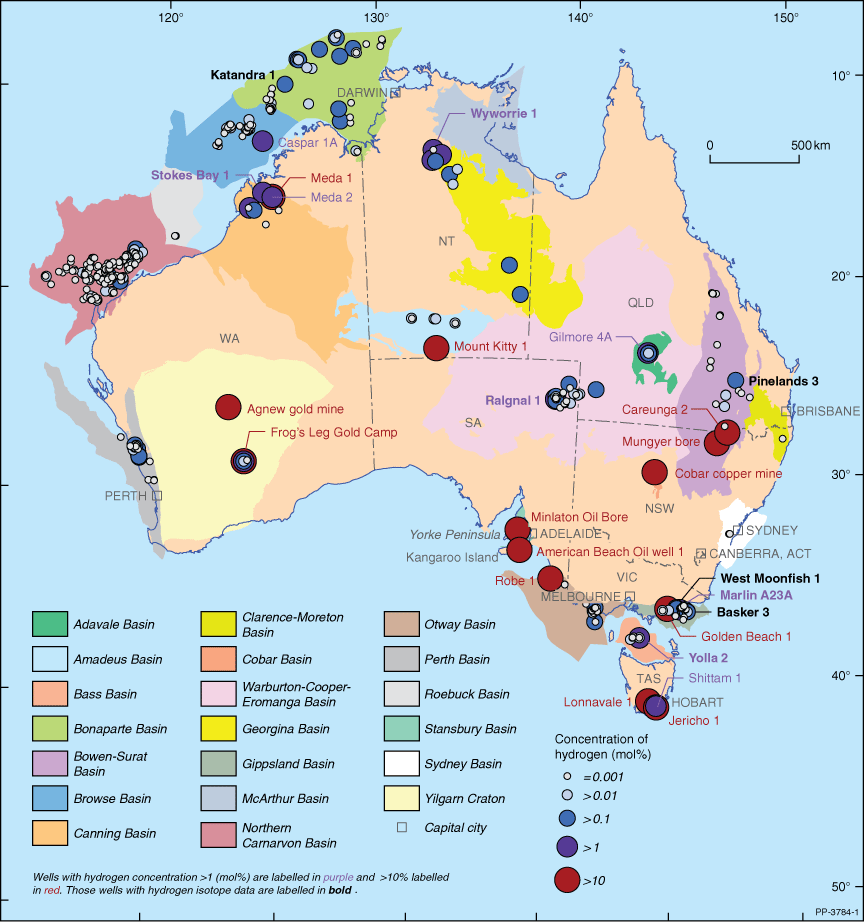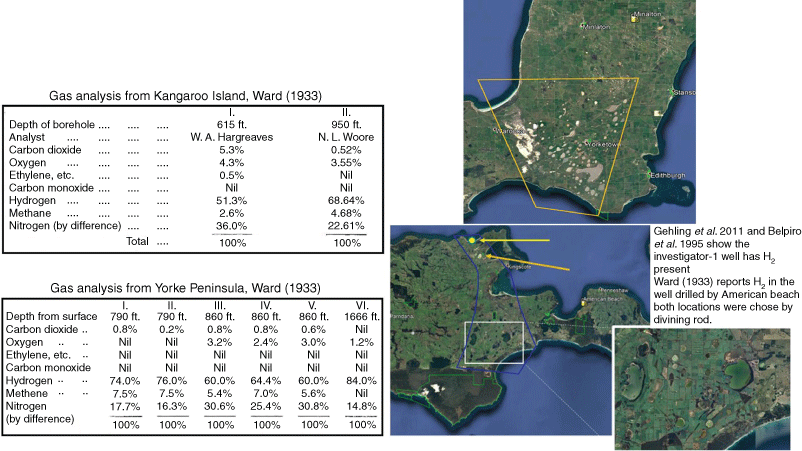Gold (hydrogen) rush: risks and uncertainties in exploring for naturally occurring hydrogen
Linda Stalker A * , Asrar Talukder A , Julian Strand A , Matthew Josh A and Mohinudeen Faiz BA CSIRO, ARRC, 26 Dick Perry Avenue, Kensington, WA 6151, Australia.
B CSIRO, QCAT, 1 Technology Court, Pullenvale, Qld 4069, Australia.
The APPEA Journal 62(1) 361-380 https://doi.org/10.1071/AJ21130
Submitted: 31 December 2021 Accepted: 28 January 2022 Published: 13 May 2022
© 2022 The Author(s) (or their employer(s)). Published by CSIRO Publishing on behalf of APPEA.
Abstract
Interest in hydrogen (H2) energy has exploded in the last few years. Much of the interest comes from transitioning to a decarbonised energy future, through the use of renewables, to convert hydrogen-rich materials (methane, water) to pure hydrogen gas streams. Each of these methods have their own challenges, such as the need for carbon capture and storage to manage carbon emissions or perspectives on the use of fresh water. At the same time as this engineered approach to generating hydrogen, there has been a quiet but exponential upsurge in research surrounding the origins and fate of naturally occurring hydrogen. Sometimes referred to as ‘gold’ or ‘white’ hydrogen, geological forms of hydrogen have been recognised for thousands of years. While already present as H2, hydrogen may exist with other gases, such as methane, helium, hydrogen sulfide and/or nitrogen. But is it real? Is it volumetrically significant, discoverable, predictable or exploitable? Early work suggests that we can begin to characterise potential sources of hydrogen, the depth ranges they may be generated from, the migration mechanisms that are relevant, and how they might be retained or lost in relation to the discovery and exploitation of this gas. However, existing publicly available data is constrained by a lack of analysis and limited evidence. While there are increased reports of seeps containing hydrogen, there is an absence of evidence of more significant finds and a lack of major analogues and case studies to date. We explore these risks and uncertainties and provide a roadmap for reducing the evidence gap.
Keywords: analysis, Australia, basement, exploration, halite, migration, natural hydrogen, proxy species, radiolysis, serpentinisation, source, trapping.
Introduction
The emergence of a hydrogen economy in recent years has stimulated a number of creative pathways to introduce hydrogen as an alternative low-emissions fuel. Hydrogen production, storage, transport and utilisation have been progressively examined as part of the value chain to deliver an increasingly electrified and net-zero society (e.g. Climate Change Committee 2021). Hydrogen as a feedstock and fuel is anticipated to play a significant role in decarbonising the industry and the energy sector and to help achieve a range of goals focused on mitigating climate change, such as the Net Zero by 2050 goals that many countries have already adopted. Exporting hydrogen or hydrogen carriers (e.g. ammonia) can help decarbonise Australia’s liquefied natural gas industry and reduce the environmental footprint of many hard-to-abate industries, such as steel, minerals and cement manufacture.
In Australia, a number of reports and papers have provided roadmaps and assessments of the current states of development for both domestic hydrogen and international export industries, including reports titled ‘Hydrogen for Australia’s Future’ (Commonwealth of Australia 2018), ‘National Hydrogen Roadmap’ (Bruce et al. 2018), ‘The Future of Hydrogen’ (IEA 2019) and the second ‘Low Emissions Technology Statement’ (DISER 2021).
These documents note the necessity of new innovation and technology to reduce the cost of hydrogen production, the need for effective storage of hydrogen post-production and prior to use, the effective transportation methods for domestic and international distribution of hydrogen or hydrogen carriers, and its ultimate utilisation – as a feedstock or fuel. Few of the above reports mention the potential for hydrogen that is not manufactured or processed from hydrogen-rich materials, i.e. from naturally occurring sources.
There has been a dramatic increase in the number of scientific papers and general reports on the presence of naturally occurring, or geological, hydrogen in the last three or so years. For a comprehensive review of observations of hydrogen in gas, sources of hydrogen and its relationship to geological features and structure, the review by Zgonnik (2020) is extremely thorough. Zgonnik (2020) has prepared an extensive global database, bringing together much of the documented western observations of hydrogen gas (not necessarily hydrogen-rich but where over 10% hydrogen has been observed in gas mixtures) with data sets from Eastern European and Russian literature sources. This has provided a more consolidated data set with which to build hypotheses on sources of hydrogen and likely places where it may be expected.
The emergence of ‘white’ or ‘gold’ hydrogen, as it has begun to be referred to, may be complementary to the other ranges of hydrogen ‘colours’ currently emerging in the marketplace. But there are still a large number of uncertainties around hydrogen formation, occurrence and longevity in the subsurface at different depths. Is it quantitatively significant? Is it more economic to produce natural hydrogen than convert methane or other hydrogen-rich base materials to hydrogen? What is the environmental footprint of the different hydrogen production pathways relative to natural hydrogen?
This paper draws together observations from a range of literature on source, migration, trapping and accumulation of naturally occurring hydrogen to build a series of criteria for discovery using an ‘exploration mindset’. However the lack of general information and specific case studies means that, for the explorationist, an open mind may be the most useful tool in the kit for considering a potentially emerging area of discovery of a low-emissions subsurface energy source.
Literature
Most literature in the hydrogen industry domain has focused on the manufacturing and industrial processes that generate hydrogen from materials rich in hydrogen (i.e. hydrocarbons, coal or water). The processes, typically steam methane reformation or electrolysis, are energy intensive, and the move to powering these processes by renewable energy is a significant step on the path to decarbonisation. When reviewing natural or geological hydrogen, most references focused on the role of underground storage of hydrogen as an alternative to the surface design of infrastructure or the role of pipelines to manage the transportation and storage of hydrogen for use.
Only in the last few years has there been a new focus on the potential for naturally generated hydrogen. Many papers have focused on discrete generation mechanisms, but few have attempted to quantify the potential for natural generation of hydrogen in the subsurface. In a paper by Sherwood Lollar et al. (2014), a range of estimates were made, which varied significantly depending on assumptions made. It had been expected that marine lithospheric water–rock reactions were significant producers of natural hydrogen and that the continental lithosphere had limited contributions (i.e. the association of hydrogen with ophiolites, particularly the gas seeps from ophiolites in the Chimera area of southwest Turkey’s Olympos Mountain, reported over the last 2500 years [Hosgörmez 2007]). The conclusion by Sherwood Lollar et al. (2014) was that hydrogen production from the Precambrian continental lithosphere was far higher than previously anticipated, having been assumed to be negligible. Rather, the combined continental Precambrian generation of hydrogen via radiolysis or hydration reactions could range from 0.36 to 1.80 × 1011 mol year−1 (Table 1).
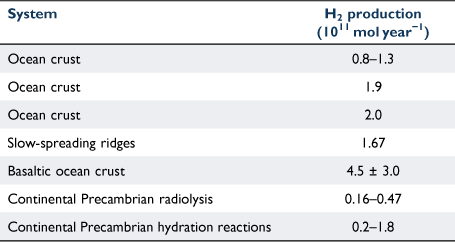
|
Subsequently, in the comprehensive review by Zgonnik (2020), a more extended collation of sources and sinks of hydrogen is presented. Their table contains a broad range of uncertainties within the measurements from individual authors and between different authors reporting measurements from the same mechanism or process, and so, it confirms a lack of systematic and quantified information on naturally occurring hydrogen. Zgonnik (2020) does note that ‘estimates have been increasing by an order of magnitude every one or two decades which is probably due to progress in an understanding of the widespread occurrence of natural hydrogen’, thus implying that it may still be an underestimated potential source of energy for the future.
Increased interest in natural hydrogen has perhaps been highlighted from two different perspectives: (1) the discovery of the hydrogen-rich Bourabougou Field in Mali (Prinzhofer et al. 2018) and (2) the extensive investigation of the circular enigmatic surface seep features (e.g. Larin et al. 2015) associated with hydrogen leakage known as ‘fairy circles’ (Frery et al. 2021; Moretti et al. 2021 and references within both of these articles).
In Australia, interest in naturally occurring hydrogen and related underground hydrogen storage (UHS) research has grown rapidly. Several papers, Boreham and Davies (2020) and Boreham et al. (2021a, 2021b) have begun consolidating observations in Australia, both on and offshore, and broader programs of work have been conducted by Geoscience Australia (GA) as part of Exploration for the Future funding. Both GA and state surveys have reviewed well completion reports (WCRs) (along with everyone else in this emerging area), and the Boreham et al. (2021a) paper consolidated this information (Fig. 1).
Bourabougou Field, Mali – an operating hydrogen gas field
The Bougou-1 well was drilled for water in the mid-1980s, but following a gas explosion, it was plugged and suspended. The well was later uncemented, and a pilot production activity was conducted from 2011 for 5 years, followed by a new drilling campaign. A comprehensive overview of the geology, geochemical analyses and research has been documented in Prinzhofer et al. (2018), although with a focus on the shallow section that is being produced for hydrogen.
The rocks in the area are Proterozoic and sedimentary in nature, interspersed by Triassic dolerite sills. The gas in Bougou-1 contained 97.4% H2 with minor He, nitrogen (N2) and C1–C5 hydrocarbons. Subsequent wells have been drilled to varying depths, and a working model of the reservoirs has been developed. The stacked reservoirs are, on the whole, quite shallow in nature relative to hydrocarbon reservoirs, in some cases as shallow as a few hundred metres. Prinzhofer et al. (2018) note evidence of pressure support, geysering or gas-lift and potentially ongoing recharge of gas to the field in real-time. Enigmatic seep features are seen around the areas that have been measured for hydrogen. The observations reported in Prinzhofer et al. (2018) and results anticipated at the time of writing that paper implied significant further work was underway. However, little of that information is currently in the public domain. The Bourabougou Field remains the most well known (and possibly only) description of an active hydrogen system that has been produced commercially. The lack of other examples or case studies remains a challenge for the development of hypotheses for future discoveries for explorationists.
Enigmatic seep features – fairy circles
Seeps have historically been used in the oil and gas industry to provide evidence of active petroleum systems. The discovery of surface oil and gas seeps, both on and offshore, provide strong evidence of active source rocks, some of which have been deep enough to generate and expel hydrocarbons, and thus reduce one risk for the explorationist.
With the advent of remote sensing and imaging, and tools such as Google Earth, the ability to identify and review enigmatic surface seep features has grown significantly. In the case of hydrogen exploration, this has been combined with new sensors or new applications of existing sensors to measure hydrogen in soil gas to provide a more comprehensive understanding of the distribution and occurrence of hydrogen from the subsurface. Frery et al. (2021) have consolidated some of the observations globally and applied them to an area north of Perth in order to identify and confirm surface indications of hydrogen seeps. A desktop study was conducted to rank a wide array of features, such as salt lakes, water courses, and other circular depressions observed remotely, before field work was conducted to characterise soil gas concentrations across and around some of the depressions. Results of the first two campaigns recorded 79 gas measurements with 0–96 ppm H2 observed (Frery et al. 2021). This top-down approach aims to connect the surface seep observations to potential deeper pathways closer to the source of hydrogen.
Hydrogen potential in Australia
The presence of thousands of enigmatic surface features and evidence in some gas samples and early WCRs have been reviewed and data consolidated by a number of different teams within government surveys, the research sector and also from a range of industry participants. Some of the earliest Australian examples of hydrogen gas in the subsurface is from reports by Ward (1933). They reported on a well from 1921 on Kangaroo Island in South Australia (SA) as having significant hydrogen presence (51.3 and 68.64% H2 at depth of 187.45 m [615 ft] and 289.56 m [950 ft] respectively). This observation, and several others, stimulated exploration activities, supported by the South Australian state government through new exploration regulations amended in February 2021. The Petroleum and Geothermal Energy Regulations 2013 declared that regulated substances include ‘hydrogen, hydrogen compounds and by-products from hydrogen production regulated substances under the Petroleum and Geothermal Energy Act 2000’ and have stimulated significant activity in the state.
Boreham et al. (2021a) gives an overview (Fig. 1) of both on and offshore instances of hydrogen discovery. In the absence of further information, populating this map has been limited by a lack of evidence. From the mid-1960s the analytical methods used for gas characterisation in exploration wells became finely tuned to measure hydrocarbon gases as a priority. Typically, modern analyses have used gas chromatography methods using flame ionisation detectors and sometimes with secondary thermal conductivity detectors. These can measure C1–C6 hydrocarbons, carbon dioxide (CO2), oxygen and N2 as a minimum. However, the carrier gases most frequently used are helium, hydrogen and air. This means that neither helium nor hydrogen are detected in that background gas mixture. The result of this has been, of course, an absence of evidence for hydrogen (and helium) in exploration and production gases.
If analytical protocols were changed (back!) to detect helium and hydrogen in addition to hydrocarbon gases, what might we discover? Is natural hydrogen about to be detected in ways in which the tight and shale gas revolution saw in the last 10 or so years? Evidence of absence or absence of evidence? What do we know so far about the potential for hydrogen being naturally sourced from underground in Australia?
An exploration mindset
Throughout this study, the research team have based their data collection and hypothesis development on an oil and gas ‘exploration mindset’. Using methods and approaches from the conventional and unconventional oil and gas exploration (such as the US Geological Survey, Charpentier and Klett 2005 and references therein) the team evaluated key aspects of exploration for hydrocarbons.
Within that thought process, keeping an open mind was critical; the evolution of the tight/shale gas industry was a strong reminder to not make any assumptions about the presence or absence of data on hydrogen. Thus, we considered both conventional and unconventional gas approaches, such as those described in Table 2.

|
Using this approach there is an opportunity to work through the various unknowns or data gaps and contribute towards de-risking investment in exploring for natural hydrogen. When applying our understanding of how oil and gas accumulates, we must address four primary unknowns: (1) the source(s) of hydrogen, (2) migration pathways from the source, (3) the hydrogen reservoir or (4) hydrogen-accumulation locations and how the hydrogen is trapped (Fig. 2). This workflow approach to identifying potential plays and prospects in the oil and gas sector was considered as a means to identify prospective areas for economic volumes of hydrogen. Note that the oil and gas sector approach took many decades to be established and that dry wells are regularly encountered to this day.
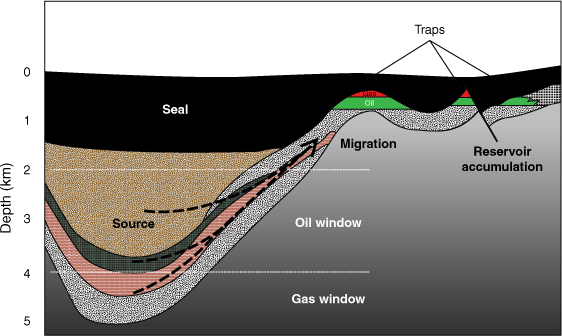
|
In brief, oil and gas exploration is based on the criteria listed in Table 3. Several of these key features could be considered essential to hydrogen exploration but they are not always equivalent. For example, in hydrocarbon exploration, a thick and organic-rich source rock is required. There are examples of abiogenic hydrocarbon-rich gases, but the predominant source rocks are organic from shale and mudstone deposition. What has become abundantly clear in reviews on hydrogen sources is that they are many and varied (Table 4). Hydrocarbon source rocks are required to be buried such that the geothermal temperature enables kerogen to generate oil before it can be expelled and migrate buoyantly upwards before accumulating in a suitable reservoir and trapped by a suitably impermeable seal (often shales and mudstones but could also be salt). Where the seal is poor or faulting has occurred, some hydrocarbons can leak and provide surface seepage evidence of a working source kitchen below (Fig. 2).

|
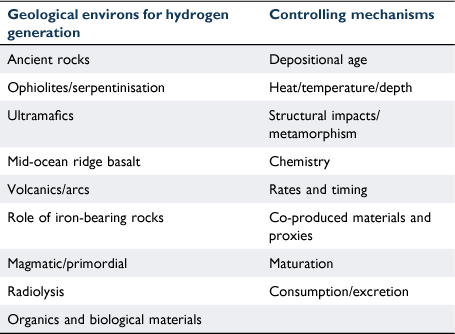
|
So, if we do want to explore for hydrogen, what might be our first hypothesis or model for discovery? What do we base it on? The team took the petroleum industry exploration mindset and worked through each of the standard components to build an exploration framework for testing in a range of potential examples in Australia.
Hydrogen source
The literature has presented many potential hydrogen sources, summarised in Table 4. They range from deep-seated origins (mantle and basement), serpentinisation (i.e. metamorphic transformation of rocks), Fischer–Tropsch-like reactions between iron and water in sediments, organic matter alteration, alteration of other gases containing hydrogen, biological activity and radioactive decay/radiolysis (Table 4). For detailed explanations of all of these sources, we refer you to Zgonnik (2020).
Many hydrocarbon source generation mechanisms are controlled by heat/temperature/burial depth. Is this true for hydrogen generation? There may also be an age relationship regarding Precambrian and ancient rocks (because of their chemistry during deposition, i.e. high in iron). The Bourabougou hydrogen gas field in Mali is within a region of Neoproterozoic rocks, with the presence of basement rocks and iron-rich minerals (Prinzhofer et al. 2018), and other observed locations may have this in common.
Geological structure and metamorphism can influence the depth at which those rocks may have been transported, perhaps reaching the optimum window for breaking down or reacting to produce hydrogen and other reactants. For example, there can be optimum temperature windows for serpentinisation to occur, transforming oceanic crust or greenstone belts to generate hydrogen at higher rates. Those rates and the timing of how sources may be juxtaposed against zones that may allow accumulation (i.e. reservoir intervals and sealing units) is critical to the trapping and build-up of quantitatively significant amounts of hydrogen. All of these sources and controls can influence which other gases and contaminants may be entrained or co-generated during migration – these co-generated materials could act as a proxy for finding hydrogen and its source(s).
What might be important to consider in future exploration plans is that locations where naturally occurring hydrogen is observed, or is identified in larger volumes, could be due to the presence of more than one source of hydrogen. Therefore, locations where there might be multiple sources could improve the flux and retention of larger accumulations of hydrogen. Flux, or a mass balance of hydrogen input and subsequent loss (leakage or consumption) from the system, will have a strong influence on our ability to find economic accumulations in the future. This was recently alluded to in Frery et al. (2021), where multiple potential sources are noted in their recently published paper.
There are clearly a large number of potential mechanisms of hydrogen generation from different geological sources. As noted earlier, estimates of hydrogen generation are currently quite varied but appear significant, leading to the suggestion that of all the exploration steps, the source may not be the highest risk for the discovery of hydrogen reserves.
Migration
The next step for developing an exploration hypothesis for finding naturally occurring hydrogen underground relates to migration of fluids to enable accumulation. There has been significant work undertaken over the years to better understand hydrocarbon migration mechanisms. But unknowns remain, as evidenced by the use of static and dynamic modelling for exploration targets frequently not matching observations or low success rates from wildcat exploration wells.
In the case of oil, a source rock may have hundreds of different molecular components that add further complexity to understanding the migration of hydrocarbons. It is a little simpler with gases, but even then we have to rely on experimental observations to mimic behaviours or provide better model input parameters (e.g. wettability and contact angles of gases in sandstones).
If it is assumed that only pure hydrogen is present, it is important to understand migration behaviour between hydrogen and the materials it is in contact with on its migration path. Therefore, understanding the interaction of hydrogen with water solubility (at a range of pressure and temperature conditions), the potential for interaction/reaction with a wide range of mineral surfaces (particularly clays), the role of organic materials (either in solid form as kerogen or in natural gas or in oils) or other behaviours such as capillarity and wettability on different mineral types, all of these still remain complex to characterise and relatively unknown.
Wettability, density and solubility of hydrogen are being increasingly studied from the perspective of UHS potential. The migration of fluids is controlled to some extent by wettability. Wetting is the ability of a liquid to maintain contact with a solid surface, which results from intermolecular interactions when the two are brought together. The degree of wetting is determined by a force balance between adhesive and cohesive forces. Significant laboratory work has been conducted by researchers to measure wettability through contact angles. Recent work by Iglauer et al. (2020) has reported a range of fluid wettability values for CO2 to improve plume migration prediction and monitoring for geological carbon storage (Fig. 3). This research group has extended the experimental designs to better understand the influence of the mineral surface type (quartz versus carbonate versus clays), fluids (brine versus unsaturated water) and the impact of organics (e.g. use of stearic acid – C18H36O2) as a proxy for an oil film (Fig. 3). Much of this work was initiated following challenges to understand the imbibition and drainage of CO2 and to predict plume migration in carbon capture and storage (hence the ability to compare with that data). This data is critical to modelling migration, and hydrogen specific data can be used to better model hydrogen migration and behaviour in UHS as well. As can be seen from Al-Yaseri and Jha (2021; Fig. 4), wettability values vary for different fluids and can be affected by different mineral types and substrates. Both Figs 3, 4 show that there is a much greater difference between CO2 and other gases, while He and N2 behave more similarly to hydrogen and could be used as proxies until further research is conducted.
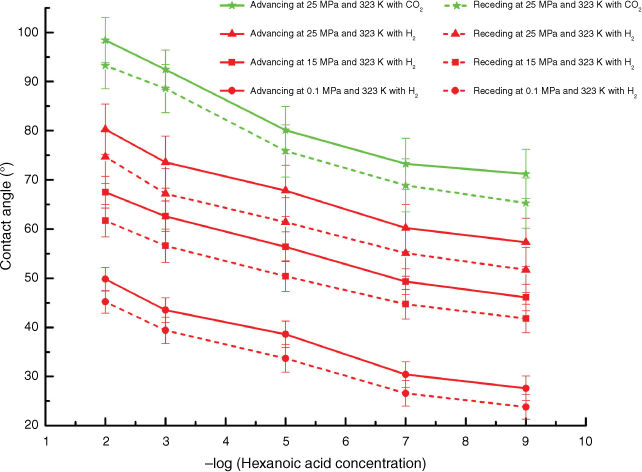
|
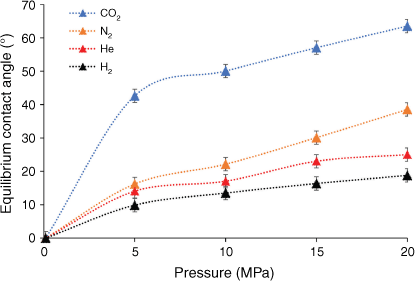
|
Other research based on computational modelling (Ennis-King et al. 2021) shows that methane and hydrogen behave much more closely in terms of fluid density over depth (i.e. temperature and pressure variation; Fig. 5). The low level of solubility of hydrogen in water at lower temperatures and shallower depths (i.e. lower MPa) has implications for how the Bourabougou hydrogen gas field in Mali retains some of its hydrogen in place at shallow depths in the upper reservoir formations (Fig. 6). The gas log data in two of the wells presented by Prinzhofer et al. (2018; Fig. 6) shows how the formation fluids (i.e. water-filled breccia) act as a seal due to the low solubility of hydrogen in water. The deeper reservoirs contain gas via the physical rock barriers of the dolerite sills of Triassic age that cut across the region.

|

|
These observations will be of interest for putting together case studies to validate why hydrogen accumulates in some places but not others. The investigations into how hydrogen-rich fluids migrate in the subsurface may have been reviewed in the domain of high-temperature mineralisation and deep crustal processes. Information on shallower sedimentary environments is only in its infancy and not yet able to be benchmarked against any real data. The increased research activity in both natural hydrogen and UHS will fill in many of the current gaps.
Trapping and accumulation
If we are to continue the parallel of using the oil and gas industry approach to exploration, the next stage to explore is the accumulation and trapping of fluids in the subsurface. The four-way closure of some anticlinal structures was often the first location targeted for drilling for oil. Structural and stratigraphic traps and the related juxtaposition of reservoir against faults or sealing rocks are documented to have held back both oil and gas extensively. There is extensive research on the role of faults on accumulations from the perspective of migration, and also loss or leakage, in the literature on hydrocarbon exploration and production.
Salt/halite or evaporitic sequences are likely to be particularly effective seals for hydrogen. Identifying evaporite horizons as part of the search for regional examples is emerging as one of the critical exploration criteria for finding good retainment of hydrogen. Evaporites typically have very low permeability and porosity levels and thus make much more effective seals for hydrogen. Early examples of natural gas and hydrogen gas storage have been conducted in locations where thick salt deposits have been flushed out to make large caverns with which to store small volumes of hydrogen. Several researchers are reviewing existing examples for future UHS and why salt caverns can be particularly effective. GA is reviewing locations of potential salt or evaporites both for natural hydrogen discoveries as well as UHS as part of their Exploration for the Future program.
But are halite seals the only effective trapping mechanism for hydrogen? The Bourabougou hydrogen gas field in Mali shows how dolerite sills have been effective at sealing units that have retarded the losses of hydrogen in some locations, resulting in the trapping and accumulation of a commercial hydrogen gas field. The dense crystalline igneous intrusions have been deposited about 200 million years ago, but the hydrogen may be far more recent.
Can shale or mudstones be sufficiently low in permeability and porosity to retard hydrogen to be an effective seal? And is the potential for a commercial discovery of hydrogen dependent on the consideration of flux rates to a much higher degree than previously observed in the oil and gas sector? This may become the most challenging aspect of hydrogen exploration and discovery.
Seeps and leaks
In oil and gas, surface expression of fluids gives major confidence that there is a source that has hit the maturation window to generate hydrocarbons that can buoyantly migrate, accumulate and be trapped somewhere in the region. Studies of hydrogen seeps through investigation of enigmatic surface features, such as fairy circles, may provide a better understanding of hydrogen’s movement and fate. However, they also demonstrate a lack of containment (i.e. accumulation and trapping are compromised). The seeps are seldom hydrogen alone and may have CH4 or N2 coexisting with the H2. The observed gas mixtures in the seeps can give some background information on the generation mechanism or source (Fig. 7).
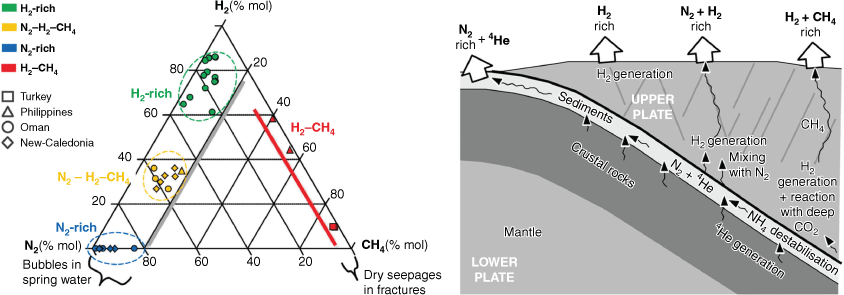
|
Fairy circles are being studied in detail (e.g. Larin et al. 2015; Zgonnik et al. 2015; Zgonnik 2020; Frery et al. 2021; Moretti et al. 2021; Rezaee 2021). In Fig. 8(1) the location of gas concentrations measured at these features show specific distributions where higher concentrations of hydrogen occur in the margins of the depressions (Larin et al. 2015). The implication of Fig. 8(1) is that faults on the margins of the feature act as conduits for the hydrogen to reach up to the surface. The other example (Fig. 8(2)) from the Carolina Bay area shows two transects across the diameter of the circular feature (Zgonnik et al. 2015). In this case, the association of higher concentrations closer to the margin of the depression is highlighted against the low values across the middle of the depression to confirm the hypothesis. The volume loss causing the depression is believed to result from changes in the granular materials, via diagenesis or weathering, to increase the depth of the centre of the depression. Examples from the North Perth Basin (Fig. 8(3)) show that these features can be observed locally in Australia.
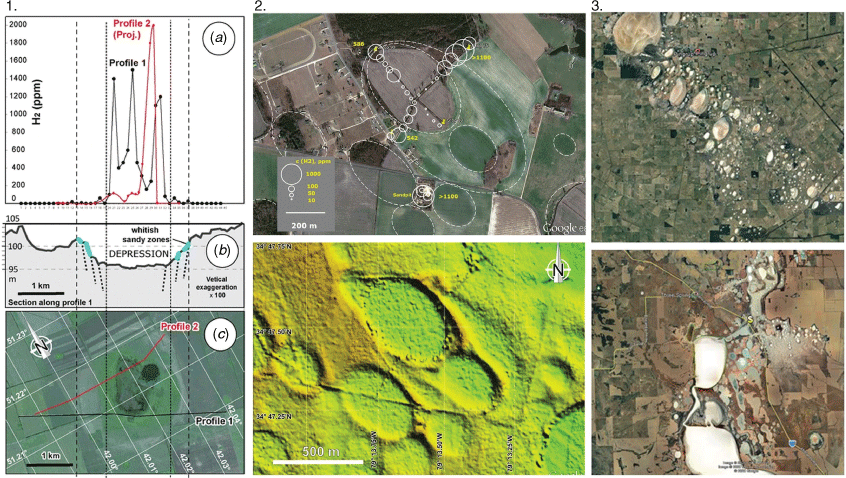
|
Some preliminary work has been conducted to develop 2D models of the evolution and behaviour of fairy circles (summarised by Myagkiy et al. 2020). Their model utilises and studies one of the few detailed sets of seepage observations from fairy circles – Sao Francisco, Brazil (Prinzhofer et al. 2019; Moretti et al. 2021). The Moretti paper acknowledges that the work conducted is the first long-term monitoring of a hydrogen associated fairy circle and that there are several features to investigate, not least of which is the periodic/episodic nature of the seeps. Hydrogen concentration variation may relate to changes in pressure caused by barometric pressure and earth tides that influence behaviour. However, the mechanism(s) of these pressure-change drivers remain unknown.
There is considerable interest in evaluating whether local or regional examples in WA and Australia could be evidence of hydrogen seepage to the surface. Quantification of hydrogen (and co-existing gases) at these locations could potentially give some metrics on the rates of change of the substrate and duration of leakage as well as flux rates overall. Previously in WA, some of these fairy circle depressions had been taken for surface expression of kimberlite pipes (i.e. to be mined for diamonds), while other locations that have these sorts of features may relate to playa lakes and other water features. Clearly, subsurface data is required to be integrated with these surface features to understand whether they may be surface indicators of leakage that contribute to an overall exploration framework.
Developing a framework for hydrogen exploration
A conceptual idea has been formulated of key criteria that might be related to an active hydrogen system and how it might be assessed for prospectivity. This has been prepared with an oil and gas exploration mindset throughout and then tested against some areas that have had historic records of hydrogen in place. The framework has been developed from looking at potential targets for exploration in Australia – noting the information gathered and what information was valued most – to enable any decision to review a site more deeply or to discard it as being unsuitable.
Synthesising information gathered on sources, migration routes and mechanisms, accumulation, trapping and surface seeps or leaks, a set of relevant criteria have been determined as ‘targets’. Table 5 shows the targets and their definitions and use to try to evaluate potential areas for more in-depth study for hydrogen reserves.
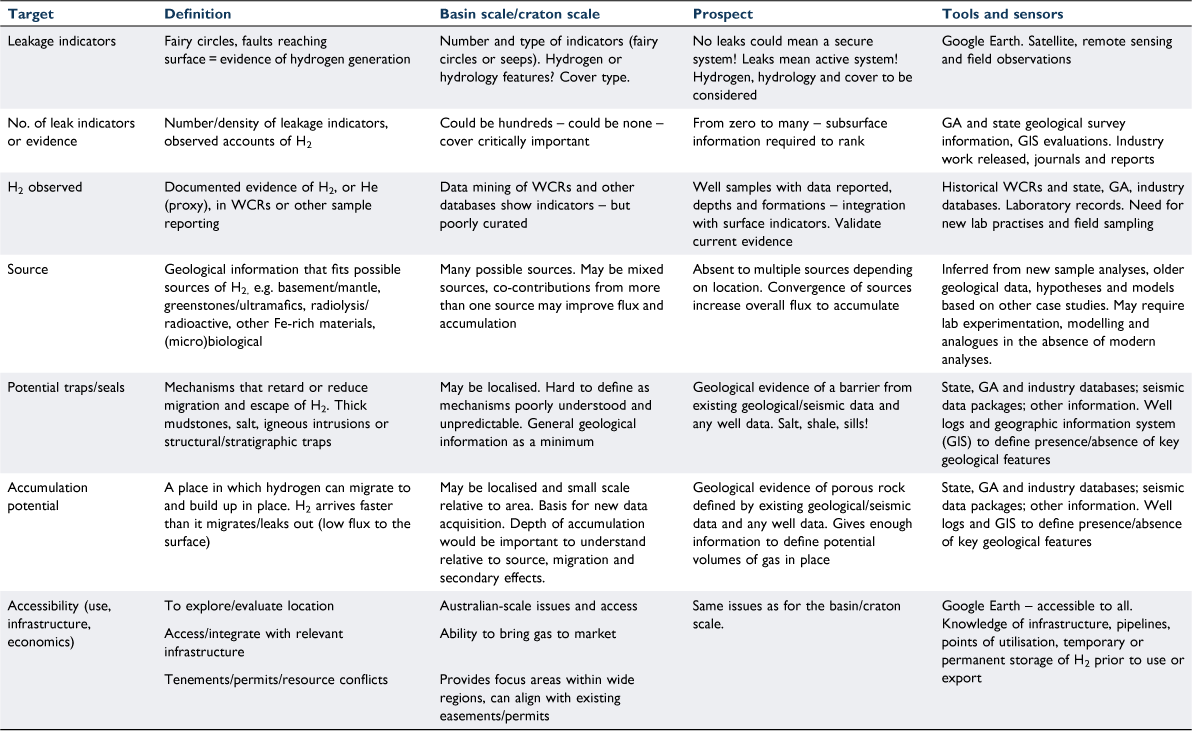
|
Leakage indicators could potentially be seeps, faults to the surface, fairy circles or other surface features that have consistently been mentioned in a range of literature as potential hydrogen seep indicators. At a basin scale, they may manifest as ‘swarms’ of enigmatic features and could be observed in high numbers. Understanding whether these surface expressions are related to hydrogen seepage or whether they relate to water courses, playas or other hydrological features (or natural gas or carbon dioxide seeps) need to be investigated by a range of tools from remote sensing to field campaigns to sample soil gas. Google Earth, for example, provides an entry point for anyone to commence evaluations of these features as potential evidence for exploring further. The presence of surface seep indicators may not be entirely good news. The small nature of hydrogen molecules makes them particularly prone to leakage, and the gas is highly reactive. This could mean that there is little remaining accumulated below ground. Flux rates will be critically important to understand.
The number of leak indicators or evidence of hydrogen noted in various sources of information could range from none to very high numbers (e.g. swarms of circular depressions; Fig. 8). However, there may be cases where, even though leaks are occurring, the superficial cover in some areas may be inadequate to develop these diagenetic depressions caused by hydrogen seepage.
Confirmed or documented observations of hydrogen (or helium), mainly from WCRs, logging information or other geological data sources have provided at least an early indicator for locations to be evaluated in more detail. Examples, such as the Aramall-1 or Meda-1 wells (North Perth Basin and Canning Basin, respectively) in Western Australia, provide some indication or evidence of deep, natural hydrogen occurrences, although the potential for corrosion or other mechanisms to contribute to the presence of hydrogen are possible. But the toolkit of WCRs, log data, and thorough studies and field activities by state surveys and GA provide extensive starting materials.
The potential source, or sources, of naturally occurring hydrogen are defined to provide some geological context and likelihood of prospectivity for hydrogen generation given the geological information documented. Evidence of greenstones, serpentinites, iron-rich rocks at optimum depths, the presence of uranium-rich rocks etc., and in some cases basement rocks, would be explored as potential sources. In particular, the presence of multiple sources would be preferred so as to optimise flux from the source and maximise accumulation. Secondary or co-existing gases often provide indications of source provenance (e.g. helium isotopes). Transitioning from broad basin-scale areas to specific prospects is still challenging in the absence of information about how natural hydrogen deposits might work. Conducting new and more detailed analytical activities on the potential for experimental and theoretical modelling studies to better understand the generation and fate of hydrogen is still required for future identification of economic natural hydrogen. Migration or transport may be diffusive, but areas with large-scale basement faults may provide ideal conduits to shallower sections that enable a body of gas to be trapped.
Trapping mechanisms that will retard full leakage of hydrogen to the surface may well be impossible, as the molecular size and reactivity of hydrogen are well known. But are those potential trapping formations identified earlier (salts, shales and igneous intrusives) present within areas where there are several seeps, documented measurements of hydrogen and multiple potential source mechanisms in place? Again, evidence from previous types of exploration may be used and should not stop at just petroleum exploration wells but include other shallower evidence as well.
Accumulation potential may be the most difficult concept to address out of the whole exploration approach for hydrogen. So little evidence of accumulation has been found over the course of this study, that it is difficult to conceptualise. The need for petroleum type reservoirs to contain materially significant quantities of hydrogen to be produced versus those discovered (i.e. so far only in Mali) suggests that accumulations may be limited. This may be due to the flux of hydrogen arriving at a location versus how much of it leaks to other intervals or to the surface. In the case of the Bourabougou Field, dynamic charge of the field has been proposed, as pressure reductions during production have not been observed. Would all hydrogen gas fields need to be dynamically recharged to be significant (and large enough to be discovered)? Therefore, areas such as the North Perth Basin may be attractive to seek hydrogen, as hydrocarbon traps and accumulations are already proven effective, but maybe within locations where rocks have reached optimum serpentinisation temperatures as well. Sources of information to understand the geology of these locations often come from the oil and gas exploration and production wells, so naturally, the locations considered prospective currently come from areas where more information is known from one perspective.
Other considerations for where to look include the potential for reaching locations to mobilise for exploration activities and how any discovered gas could be integrated with existing infrastructure or easily transferred to users of hydrogen gas (e.g. to decarbonise mining and mineral processing in some more remote areas, or for local heating/cooling and electricity generation).
How deep is the accumulation? We anticipate that some accumulations could be deep and relate to deeper sources of hydrogen, potentially from mantle or basement, and migrating up large-scale basement faults. Other discoveries may be very shallow with respect to the oil and gas sector, due to the behaviour of hydrogen in formation water, as noted in the Mali case, where water-filled breccia could act as a barrier at depths of the order of 100 m (Prinzhofer et al. 2018).
All of these factors illustrated in the matrix developed and presented in Table 5 can help define more prospective locations to explore. So, how has this framework helped us identify locations that could be worth a closer look?
Discussion
Using the framework described in Table 5, the team evaluated a series of locations to determine which areas might have future potential for hydrogen exploration. The shortlist included areas in the North Perth Basin, Yilgarn Craton, Kangaroo Island and Yorke Peninsula, Lake Dora (South Canning), Amadeus Basin and North Canning Basin (Table 6). We provide four examples to demonstrate the framework and test its efficacy for hydrogen exploration.

|
North Perth Basin
The North Perth Basin is a known hydrocarbon exploration and production area, but it may also be in the presence of multiple sources of hydrogen: it is located in a serpentinisation sweetspot (7–12 km below is a band of ultramafic materials) that is adjacent or potentially underlying the Yilgarn basement, with appropriate mineralogy and granites that could facilitate radiolysis of water. Reservoirs and thick shale sequences with low porosity and permeability have a proven track record of retarding oil and natural gas from leaking. Aramall-1 is reported to contain 50–75% H2 (WCR). The majority of the gas recovered from the Kockatea Shale was hydrogen in that well. It is not a commonly tested formation in North Perth Basin wells, as it is a seal rather than a reservoir. There are also abundant leakage indicators that can be tied to structural features. The Aramall-1 intersects basement rock and is well faulted in the area (Fig. 9).

|
South Australia
Kangaroo Island and Yorke Peninsula have documented occurrences of hydrogen from well samples from 100 years ago (Fig. 10). Potential source rocks and leakage indicators have already stimulated significant interest in this and other parts of SA. Of particular note is the shallow depth at which some of the observations have been made, which fit, to some extent, with the observations in Mali (Prinzhofer et al. 2018).
Recent drilling and sampling at the Frog’s Leg Camp mine (Boreham et al. 2021b) have shown the presence of hydrogen at shallow depths and its association with gold prospectivity. Other features of the Yilgarn Craton provide interesting comparisons with the Mali discovery (i.e. ancient rocks, deep basement faults, igneous intrusives as seals).
Central Australia
The Amadeus Basin has documented discoveries of both hydrogen and helium in Mt Kitty-1 and helium in Magee-1. The value of helium in recent times has made the region more prospective for that alone. Both these wells intersect the basement below the Gillen Evaporite, thus bringing together a superior seal and at least one potential source from basement rocks, suggesting that the region may be suitable for further exploration (Fig. 11).
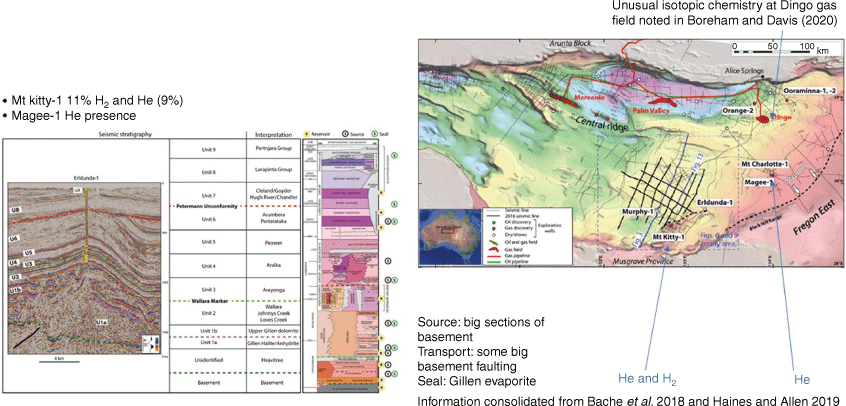
|
North Canning Basin
One other initial candidate has been evaluated using our hydrogen exploration framework: the Meda-1 well and area in the North Canning Basin. Discovered in the late 1950s, Meda-1 was extensively tested with nine drill stem tests (DSTs). In the shallower intervals, a range of gas hydrocarbon and non-hydrocarbon compounds were identified, including hydrogen (Fig. 12). DST 9 in the Lower Carboniferous Laurel Formation contained gas with over 90% H2 as determined from two samples. The cross-section (Fig. 12) shows that Meda-1 intersected basement (like that of the Amadeus Basin examples of Mt Kitty- and Magee-1 and also the Arramall-1 well in the North Perth Basin). A review of geophysical data in the area might provide more information on the potential for deep fault systems to act as conduits from basement rocks and other potential hydrogen sources within the Kimberly Craton.
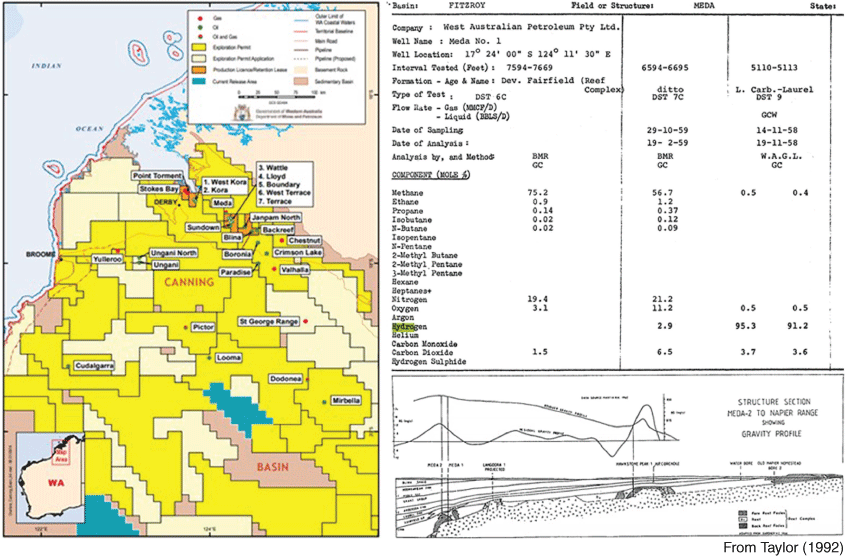
|
The absence of suitable locations for validating the presence of hydrogen in Australia and globally makes this location of particular interest for further study to unpack possible sources of hydrogen and how they have migrated and potentially accumulated in the area. There is evidence of uranium-rich rocks in the region that may also contribute towards a radiolysis mechanism for hydrogen generation in addition to the deeper basement rocks. A multiple-source model may be another key feature necessary for the exploration criteria.
Other considerations
The combined reviews and attempts to build hydrogen exploration models for this study have, of course, led to further questions. In terms of hydrogen source, there are many mechanisms and potential for hydrogen to be generated from a variety of geological environments (Table 1). Not considered here is the influence of microbiological activity either as a producer or consumer of hydrogen. So, could hydrogen be everywhere?
The absence of evidence for hydrogen in the subsurface has come from a number of issues. Firstly, there is a likely sample bias caused using vessels that are unable to contain light molecules for long periods or may react with vessel walls. The analytical protocols used to analyse any gases collected during hydrocarbon exploration transitioned in the mid-1960s to focus solely on hydrocarbons and ignored gases that were irrelevant to oil and gas exploration. Often samples are simply not taken when there have been opportunities – as this comes at a cost. This is reflected in both the lack of DSTs, or similar samples, or the limited core collection, which is now proving problematic in assessments of locations for geological carbon storage. Have related well logs been revisited to determine whether gases might be present in some features but not hydrocarbon gases?
Further, even if samples were taken, were they taken in relevant intervals at relevant depths? A sampling bias of deeper sections in hydrocarbon exploration could mean that shallower gas pockets have been drilled through and overlooked. There is evidence from Mali and SA (Kangaroo Island and Yorke Peninsula data by Ward in 1933) that some of the hydrogen gas could be as shallow as a few hundred metres.
So where to from here? The most challenging problem to date is the lack of worked examples of either commercial fields (e.g. Bourabougou Field in Mali [Prinzhofer et al. 2018]) or confirmation of observations made more locally (e.g. Meda-1). The lack of information regarding where hydrogen may have been observed in the past has limited considerations for future exploration and restricts our thinking around potential exploration models.
Currently, this gap is being reduced by the investigation of surface expressions, such as mapping and research to characterise fairy circles and their underlying plumbing (e.g. Frery et al. 2021; Moretti et al. 2021). These studies have shown that the hydrogen expressed at the surface is periodic and controlled by a range of factors. Measuring hydrogen in soil gas in the field, however, requires both concentration and flux measurements to be conducted to better understand rates of migration, rates of loss from escape versus diagenetic reactions, or microbial activity (e.g. Myagkiy et al. 2020).
Analytical methods for field characterisation are improving rapidly, and the need to analyse gas samples taken during drilling of exploration wells for hydrogen, helium and other indicators needs to be reinstated. This only takes the data collection so far, as few exploration wells are being drilled currently, and it is less likely that samples are being taken across the whole depth interval drilled. Samples of opportunity, such as those coordinated by Boreham et al. (2021b) via shallower mineral exploration wells could begin to provide a greater variety of data points that could help us to understand more about the distribution, occurrence and fate of hydrogen in a broader range of geological environments.
Summary and conclusions
The days of hydrogen exploration may be early, and there may be false starts along the way; however, there are actions that can be taken to rapidly improve our understanding of the potential for economic hydrogen exploration and production in the future.
There are many different mechanisms for generating hydrogen in the subsurface. Possibly multiple mechanisms are responsible for the observed presence of hydrogen in some locations in larger quantities. This suggests that the source mechanism(s) to generate hydrogen may not be the rate-limiting step or highest risk for future exploration out of a source-migration-trapping-accumulation style exploration mindset. Evidence from the literature and calculations suggest it is possible that hydrogen could be more prevalent than initially considered and in more geological environments than have been previously realised (e.g. Sherwood Lollar et al. 2014; Boreham et al. 2021a).
However, the rates of generation are less well understood for a given rock composition/pressure/temperature, and there is limited quantified or semi-quantified data on each of the generation mechanisms and their relative contributions to any possible discoveries. Some of this could be explored via both modelling and laboratory-based experimental work to reduce uncertainties relating to rates of generation versus loss through chemical/mineral reactions or microbiological consumption.
Hydrogen is highly mobile and may use different pathways to migrate depending on depth and pressure. Water solubility, wettability, interaction with mineral surfaces and microporosity may be critical factors under different temperature and pressure conditions.
Trapping hydrogen so that it does not reach the Earth’s surface/atmosphere is likely to be a greater rate-limiting factor than generation. Trapping by salt/evaporitic sequences or very low permeability rocks, such as dolerite sills, is highly effective (as seen from UHS studies and the Mali case study, respectively). The role of shales or mudstones (typically having low enough porosity/permeability ranges for oil and gas) remain uncertain as seals for hydrogen at this stage. Again, further laboratory experimental work could provide more information and reduce risk.
Accumulation of significant amounts of hydrogen for extraction may rely on porous rocks sitting just beneath any superior trapping layers (a reservoir?) but due to a lack of hydrogen discoveries and related examples, at this stage, only oil and gas analogies can be hypothesised. This is a major unknown and requires further consideration. In addition, the depth of accumulation needs to be extended beyond the samples available from the oil and gas industry depending on some of the physical properties of how hydrogen interacts with formation water. Very shallow depths are typically bypassed during hydrocarbon exploration. This may seem in opposition to the anticipated potential for hydrogen sources to be deep and reliant on major basement faults for migration in some cases.
Fairy circles are enigmatic indicators of potential hydrogen seepage. They are an increased subject of study by researchers and universities, but their role in future exploration is double-sided. They provide evidence of some form of working source, but there is also strong evidence of a lack of seal in the immediate area. However, their presence does provide a top-down mechanism to explore further and determine whether a pathway to a source can be detected. It also enables further observation of how hydrogen behaves in these environments and obtaining new types of data in these locations can only improve hypotheses and models for broader exploration.
In the absence of identified and well-characterised hydrogen-rich subsurface accumulations or surface seeps in areas that are accessible for detailed investigation, laboratory and controlled/shallow release demonstrations may be required to obtain information for predicting and modelling hydrogen behaviour to identify quantitatively significant accumulations of natural hydrogen. This could enable the testing of predictive tools for how hydrogen moves underground and its fate near surface while improving the input parameters for static and dynamic models of the movement of hydrogen and its fate.
Most prospective areas to look at currently are those in which hydrogen has been observed and documented in the past. These observations need validation to confirm the presence of natural sources versus sample biases or drilling artefacts (Moretti et al. 2021). There are some examples in Australia, and most of these have been identified via oil and gas industry data, which bias the observations seen to date. By taking observed occurrences of hydrogen and conducting a review of available geological data, revisiting, reprocessing and surveying these areas could help improve exploration criteria. Extending sampling to shallower depths, perhaps via mineral drilling and water sampling, more data across a broader geological framework could provide a wider range of potential locations for future hydrogen exploration.
Keeping an open mind will help to determine the size of the potential prize in the future. We conclude that the following considerations should be made when exploring for naturally occurring or gold hydrogen:
Multiple sources
Basement or large-scale faults
Potential for very shallow accumulations
Confirmation of existing reports of hydrogen
Acquiring flux data and considering dynamic recharge models
Surface seeps and evidence from fairy circles.
Data availability
Data sharing is not applicable as no new data were generated or analysed during this study.
Conflicts of interest
The authors declare no conflict of interest.
Declaration of funding
The work was undertaken in a collaboration between CSIRO and an external organisation.
Acknowledgements
The authors acknowledge CSIRO for the opportunity to present this work and publish this paper. The co-funder is acknowledged for their contribution to discussions and the opportunity to publish this work.
References
Al-Yaseri, A, and Jha, NK (2021). On hydrogen wettability of basaltic rock. Journal of Petroleum Science and Engineering 200, 108387.| On hydrogen wettability of basaltic rock.Crossref | GoogleScholarGoogle Scholar |
Bache, F, Walshe, P, Gusterhuber, J, Menpes, S, Sheridan, M, Vlasov, S, and Holmes, L (2018). Exploration of the south-eastern part of the Frontier Amadeus Basin, Northern Territory, Australia. The APPEA Journal 58, 190–208.
| Exploration of the south-eastern part of the Frontier Amadeus Basin, Northern Territory, Australia.Crossref | GoogleScholarGoogle Scholar |
Belperio AP (1995) A Guide to the Geology of Kangaroo Island, Department of Mines and Energy Geological Survey South Australia, Report Book 95/1, DME 425/89, January 1995.
Boreham, CJ, and Davies, JB (2020). Carbon and hydrogen isotopes of the wet gases produced by gamma-ray induced polymerisation of methane: insights into radiogenic mechanism and natural gas formation. Radiation Physics and Chemistry 168, 108546.
| Carbon and hydrogen isotopes of the wet gases produced by gamma-ray induced polymerisation of methane: insights into radiogenic mechanism and natural gas formation.Crossref | GoogleScholarGoogle Scholar |
Boreham, CJ, Edwards, DS, Czado, K, Rollet, N, Wang, L, van der Wielen, S, Champion, D, Blewett, R, Feitz, A, and Henson, PA (2021a). Hydrogen in Australian natural gas: occurrences, sources and resources. The APPEA Journal 61, 163–191.
| Hydrogen in Australian natural gas: occurrences, sources and resources.Crossref | GoogleScholarGoogle Scholar |
Boreham, CJ, Sohn, JH, Cox, N, Williams, J, Hong, Z, and Kendrick, MA (2021b). Hydrogen and hydrocarbons associated with the Neoarchean Frog’s Leg Gold Camp, Yilgarn Craton, Western Australia. Chemical Geology 575, 120098.
| Hydrogen and hydrocarbons associated with the Neoarchean Frog’s Leg Gold Camp, Yilgarn Craton, Western Australia.Crossref | GoogleScholarGoogle Scholar |
Bruce S, Temminghoff M, Hayward J, Schmidt E, Munnings C, Palfreyman D, Hartley PG (2018) ‘National Hydrogen Roadmap, Pathways to an economically sustainable hydrogen industry in Australia.’ (CSIRO: Australia) Available at https://www.csiro.au/en/work-with-us/services/consultancy-strategic-advice-services/csiro-futures/futures-reports/hydrogen-roadmap
Charpentier, RR, and Klett, TR (2005). Guiding Principles of USGS Methodology for Assessment of Undiscovered conventional Oil and Gas Resources. Natural Resource Research 14, 175–186.
| Guiding Principles of USGS Methodology for Assessment of Undiscovered conventional Oil and Gas Resources.Crossref | GoogleScholarGoogle Scholar |
Climate Change Committee (2021) Independent assessment: The UK’s Net Zero Strategy, October 2021. Available at https://www.theccc.org.uk/publication/independent-assessment-the-uks-net-zero-strategy/ [Accessed 5 November 2021]
Commonwealth of Australia (2018) Hydrogen for Australia’s Future. A briefing paper for the COAG Energy Council Prepared by the Hydrogen Strategy Group August 2018. Available at: https://www.chiefscientist.gov.au/2018/08/briefing-paper-hydrogen-for-australias-future/ [Accessed 5 November 2021]
Crostella A (1995) An evaluation of the hydrocarbon potential of the onshore Northern Perth Basin, Western Australia. Geological Survey of Western Australia. Report 43.
DISER (2021) Low Emissions Technology Statement 2021. Department of Industry, Science, Energy and Resources. Available at https://www.industry.gov.au/data-and-publications/technology-investment-roadmap-low-emissions-technology-statement-2021
Edgoose CJ (2013) Chapter 23: Amadeus Basin In ‘Geology and mineral resources of the Northern Territory’. Special Publication 5. (Ahmad M, Munson TJ, compilers) (Northern Territory Geological Survey) Available at https://geoscience.nt.gov.au/gemis/ntgsjspui/handle/1/81503
Ennis-King J, Michael K, Strand J, Sander R, Green C (2021) Underground storage of hydrogen: mapping out the options for Australia. Project number RP1-1.04. Deliverable Number 5. Final Summary Report. CSIRO and Future Fuels CRC. Available at https://www.futurefuelscrc.com/wp-content/uploads/FutureFuelsCRC_UndergroundHydrogenStorage2021.pdf [Accessed 31 December 2021]
Frery, E, Langhi, L, Maison, M, and Moretti, I (2021). Natural hydrogen seeps identified in the North Perth Basin, Western Australia. International Journal of Hydrogen Energy 46, 31158–31173.
| Natural hydrogen seeps identified in the North Perth Basin, Western Australia.Crossref | GoogleScholarGoogle Scholar |
Gehling, JG, Jago, JB, Paterson, JR, García-Bellido, DC, and Edgecombe, GD (2011). The geological context of the Lower Cambrian (Series 2) Emu Bay Shale Lagerstätte and adjacent stratigraphic units, Kangaroo Island, South Australia. Australian Journal of Earth Sciences 58, 243–257.
| The geological context of the Lower Cambrian (Series 2) Emu Bay Shale Lagerstätte and adjacent stratigraphic units, Kangaroo Island, South Australia.Crossref | GoogleScholarGoogle Scholar |
Haines PW, Allen HJ (2019) Hydrocarbon and helium prospectivity of the Amadeus and Murraba basins in Western Australia. In ‘West Australian Basins Symposium 2019, 2–5 September 2019, Perth, WA.’
Hosgörmez, H (2007). Origin of the natural gas seep of Çirali (Chimera), Turkey: Site of the first Olympic fire. Journal of Asian Earth Sciences 30, 131–141.
IEA (2019) The Future of Hydrogen, Seizing today’s Opportunities. Report prepared by the IEA for the G20, Japan. Available at https://www.iea.org/reports/the-future-of-hydrogen
Iglauer, S, Ali, M, and Keshavarz, A (2020). Hydrogen Wettability of Sandstone Reservoirs: Implications for Hydrogen Geo-Storage. Geophysical Research Letters 48, e2020GL090814.
| Hydrogen Wettability of Sandstone Reservoirs: Implications for Hydrogen Geo-Storage.Crossref | GoogleScholarGoogle Scholar |
Larin, N, Zgonnik, V, Rodina, S, Deville, E, Prinzhofer, A, and Larin, VN (2015). Natural Molecular Hydrogen Seepage Associated with Surficial, Rounded Depressions on the European Craton in Russia. Natural Resources Research 24, 369–383.
| Natural Molecular Hydrogen Seepage Associated with Surficial, Rounded Depressions on the European Craton in Russia.Crossref | GoogleScholarGoogle Scholar |
Moretti, I, Brouilly, E, Loiseau, K, Prinzhofer, A, and Deville, E (2021). Hydrogen Emanations in Intracratonic Areas: New Guide Lines for Early Exploration Basin Screening. Geosciences 11, 145.
| Hydrogen Emanations in Intracratonic Areas: New Guide Lines for Early Exploration Basin Screening.Crossref | GoogleScholarGoogle Scholar |
Mory AJ, Iasky RP (1996) Stratigraphy and structure of the onshore Northern Perth Basin, Western Australia. Western Australia Geological Survey Report 46. Available at https://library.dbca.wa.gov.au/static/Journals/080325/080325-46.pdf [Accessed 31 December 2021]
Myagkiy, A, Moretti, I, and Brunet, F (2020). Space and time distribution of subsurface H2 concentration in so-called ‘fairy circles’: Insight from a conceptual 2-D transport model. BSGF Earth Sciences Bulletin 191, 13..
| Space and time distribution of subsurface H2 concentration in so-called ‘fairy circles’: Insight from a conceptual 2-D transport model.Crossref | GoogleScholarGoogle Scholar |
Normington VJ, Donnellan N, Edgoose C (2015) Neoproterozoic evolution of the Amadeus Basin: evidence from sediment provenance and mafic magmatism. In ‘Annual Geoscience Exploration Seminar (AGES) 2015. Record of abstracts’. Northern Territory Geological Survey, Record 2015-002, pp. 73–78.
Prinzhofer, A, Cisse, CST, and Diallo, AB (2018). Discovery of a large accumulation of natural hydrogen in Bourakebougou (Mali). International Journal of Hydrogen Energy 43, 19315–19326.
| Discovery of a large accumulation of natural hydrogen in Bourakebougou (Mali).Crossref | GoogleScholarGoogle Scholar |
Prinzhofer, A, Moretti, I, Françolin, J, Pacheco, C, D’Agostino, A, Werly, J, and Rupin, F (2019). Natural hydrogen continuous emission from sedimentary basins: The example of a Brazilian H2-emitting structure. International Journal of Hydrogen Energy 44, 5676–5685.
| Natural hydrogen continuous emission from sedimentary basins: The example of a Brazilian H2-emitting structure.Crossref | GoogleScholarGoogle Scholar |
Rezaee, R (2021). Assessment of natural hydrogen systems in Western Australia. International Journal of Hydrogen Energy 46, 33068–33077.
| Assessment of natural hydrogen systems in Western Australia.Crossref | GoogleScholarGoogle Scholar |
Sherwood Lollar, B, Onstott, TC, Lacrampe-Couloume, G, and Ballentine, CJ (2014). The contribution of the Precambrian continental lithosphere to global H2 production. Nature 516, 379–382.
| The contribution of the Precambrian continental lithosphere to global H2 production.Crossref | GoogleScholarGoogle Scholar |
Song, T, and Cawood, PA (2000). Structural styles in the Perth Basin associated with the Mesozoic break-up of Greater India and Australia. Tectonophysics 317, 55–72.
| Structural styles in the Perth Basin associated with the Mesozoic break-up of Greater India and Australia.Crossref | GoogleScholarGoogle Scholar |
Taylor, DD (1992). Blina Oilfield, Canning Basin, case history. Exploration Geophysics 23, 467–480.
| Blina Oilfield, Canning Basin, case history.Crossref | GoogleScholarGoogle Scholar |
Vacquand, C, Deville, E, Beaumont, V, Guyot, F, Sissmann, O, Pillot, D, Arcilla, C, and Prinzhofer, A (2018). Reduced gas seepages in ophiolitic complexes: Evidences for multiple origins of the H2-CH4-N2 gas mixtures. Geochimica et Cosmochimica Acta 223, 437–461.
| Reduced gas seepages in ophiolitic complexes: Evidences for multiple origins of the H2-CH4-N2 gas mixtures.Crossref | GoogleScholarGoogle Scholar |
Varma, S, Underschultz, J, Giger, SB, Field, B, Roncaglia, L, Hodgkinson, J, and Hilditch, D (2013). CO2 geosequestration potential in the Northern Perth Basin, Western Australia Australian Journal of Earth Sciences 60, 23–44.
| CO2 geosequestration potential in the Northern Perth Basin, Western AustraliaCrossref | GoogleScholarGoogle Scholar |
Ward, LK (1933). Inflammable gasses occluded in the Pre-Paleozoic rocks of South Australia. Transactions and Proceedings of the Royal Society of South Australia 57, 42–47.
Zgonnik, V (2020). The occurrence and geoscience of natural hydrogen: a comprehensive review. Earth-Science Reviews 203, 103140.
| The occurrence and geoscience of natural hydrogen: a comprehensive review.Crossref | GoogleScholarGoogle Scholar |
Zgonnik, V, Beaumont, V, Deville, E, Larin, N, Pillot, D, and Farrell, KM (2015). Evidence for natural molecular hydrogen seepage associated with Carolina bays (surficial, ovoid depressions on the Atlantic Coastal Plain, Province of the USA). Progress in Earth and Planetary Science 2, 31.
| Evidence for natural molecular hydrogen seepage associated with Carolina bays (surficial, ovoid depressions on the Atlantic Coastal Plain, Province of the USA).Crossref | GoogleScholarGoogle Scholar |

Dr Linda Stalker obtained a BSc (Hons) in Applied Geology (University of Strathclyde, Scotland) in 1990. Her PhD on petroleum geochemistry and carbon dioxide (CO2) generation was gained at the University of Newcastle-upon-Tyne. In 1994 she joined the University of Oklahoma (USA) on a Department of Energy sponsored post doctoral study into organosulfur compounds trapped in coals. From 1996, she worked in petroleum exploration and production (E&P) at Statoil, Norway, including 2 years on the Sleipner Field. She joined CSIRO in 2000 and has held numerous positions while maintaining research expertise in hydrocarbon E&P and carbon storage research. She is a member of the American Association of Petroleum Geologists (AAPG) and the Geochemical Society. Linda has also held the roles of Science Director for the National Geosequestration Laboratory and Acting-CEO of the Western Australian Energy Research Alliance. She is currently a Senior Principal Research Scientist and the Gas Industry Social and Environmental Research Alliance State Leader for WA, SA and Vic. https://people.csiro.au/S/L/Linda-Stalker. |

Dr Asrar Talukder is a Senior Research Scientist at CSIRO. He completed his PhD at the University of Granada in Spain in 2003. From 2004 to 2007, he worked as Postdoctoral Research Fellow at the GEOMAR Helmholtz Centre for Ocean Research at Kiel, Germany. During his postdoctoral work, Asrar worked on the gas hydrate deposit mechanisms on the Pacific margin, offshore Centre America. In late 2007, he joined CSIRO Energy based in Perth. Asrar’s main research interests are submarine natural seep plumbing systems; seabed processes associated with the seeps, including submarine landslides; and how hydrocarbons migrate from seeping points on the seabed to the sea surface. |

Dr Julian Strand is a Senior Research Scientist at CSIRO Energy. He is primarily working on structural geology and issues related to incorporating structural geology into reservoir basin models and applying this to hydrogen and CO2 storage. Julian has been based in Perth since 2005, and he was part of the Fault Analysis Group for 9 years at the University of Liverpool and later at the University College Dublin (Ireland). He attended the University of Liverpool and Imperial College, London. |

Dr Matthew Josh is currently employed at CSIRO to develop methods of broadband rock electrical properties characterisation. Matthew’s primary field of training is in electrical engineering and physics, and he specialises in experimental electromagnetic instrumentation and methods. He graduated with a PhD in geophysics from the University of Sydney in 2004, investigating the development of novel borehole dielectric logging tools for use in the geotechnical and extractive industries. Prior to this, he was working with Cooperative Research Centre Mining and CSIRO industrial physics, where he was involved in the development of ground probing radar to assist in fault and dyke detection in coal mining operations and for agricultural purposes, such as identifying wetting fronts during crop irrigation to improve water management. |

Mohinudeen Faiz is a Petroleum Geoscientist with ~30 years of experience in operational and research and development projects. Faiz holds PhD and MSc degrees from the University of Wollongong and a BSc (Hons) from the University of Peradeniya, Sri Lanka. He is currently a Principal Research Scientist at CSIRO Energy, where he focuses on integrated petroleum systems analyses for both conventional and unconventional reservoirs. Previously, Faiz worked at Origin Energy, where he modelled organic geochemistry and petroleum systems for small and medium enterprises, and he contributed to various exploration and development projects in Australia and overseas. He is a member of AAPG, PESA and the International Committee for Coal and Organic Petrology. |


